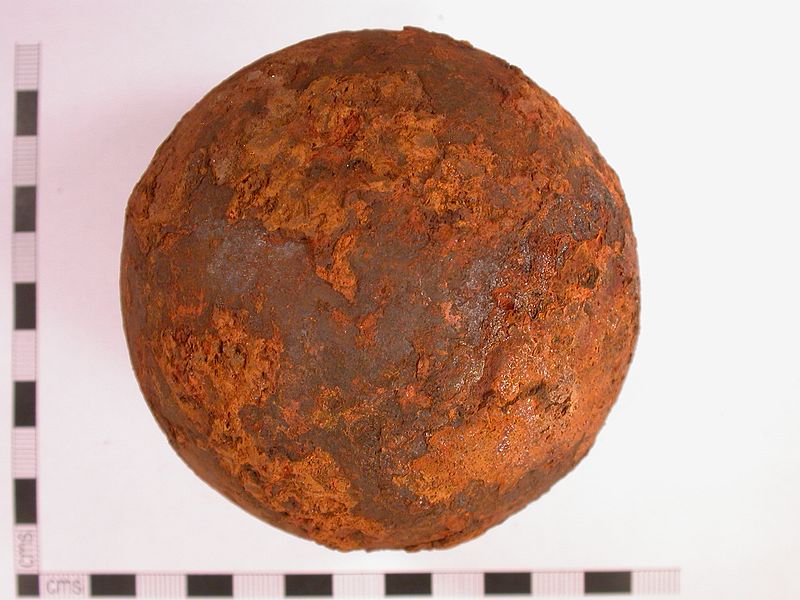File:Cannon ball (FindID 501303).jpg

Original file (1,280 × 960 pixels, file size: 378 KB, MIME type: image/jpeg)
Captions
Captions
Summary[edit]
| cannon ball | |||
|---|---|---|---|
| Photographer |
Royal Institution of Cornwall, Anna Tyacke, 2012-05-03 11:10:40 |
||
| Title |
cannon ball |
||
| Description |
English: Cast iron cannon ball, spherical in shape, pitted and corroded on the surface but not damaged from use. The diameter of 82 mm and weight of almost 2kg of the cannon ball compares well with examples of Civil War shot in the Royal Institution of Cornwall's collections, in particular a cannon ball from Castle Dore, Lostwithiel (TRURI 1992.91) and another from Tresillian Bridge (TRURI 1993.8), both Civil Ware battle sites. The size and weight of the ball suggests that it would fit a 'Minion' cannon which had a 3.5 inch bore and shot a 4 pound ball (Bailey, 2000, 95). These were used from the 16th century to the late 17th century but saw action in the Civil War as an antipersonnel weapon when it was known as a 'Minion Drake', derived from either the Latin word for dragon, draco, or from the famous seafarer Sir Francis Drake. The cannon ball was found just by the road from St Austell to Mevagissey and close to the river which would have been navigable in the 17th century, though it has since silted up from mine waste. The closest landing place would have been Pentewan which was used as a port before Hawkins' harbour of the 1820s in order to transport stone from the quarries at Polrudden from the 16th century. Even though there is not a battle site nearby the main southern estuaries in this area were all controlled during the Civil War, and the Parliamentarians must have travelled and foraged between battles in the Lostwithiel, Tywardreath and Par areas and the Tregony area of the Roseland, particularly in the summer of 1644 (Roger Smith pers comm). |
||
| Depicted place | (County of findspot) Cornwall | ||
| Date |
between 1600 and 1700 date QS:P571,+1500-00-00T00:00:00Z/6,P1319,+1600-00-00T00:00:00Z/9,P1326,+1700-00-00T00:00:00Z/9 |
||
| Accession number |
FindID: 501303 Old ref: CORN-251B02 Filename: DSCN8204.JPG |
||
| Credit line |
|
||
| Source |
https://finds.org.uk/database/ajax/download/id/379933 Catalog: https://finds.org.uk/database/images/image/id/379933/recordtype/artefacts archive copy at the Wayback Machine Artefact: https://finds.org.uk/database/artefacts/record/id/501303 |
||
| Permission (Reusing this file) |
Attribution-ShareAlike License | ||
Licensing[edit]
- You are free:
- to share – to copy, distribute and transmit the work
- to remix – to adapt the work
- Under the following conditions:
- attribution – You must give appropriate credit, provide a link to the license, and indicate if changes were made. You may do so in any reasonable manner, but not in any way that suggests the licensor endorses you or your use.
- share alike – If you remix, transform, or build upon the material, you must distribute your contributions under the same or compatible license as the original.
File history
Click on a date/time to view the file as it appeared at that time.
| Date/Time | Thumbnail | Dimensions | User | Comment | |
|---|---|---|---|---|---|
| current | 18:55, 24 January 2017 |  | 1,280 × 960 (378 KB) | Fæ (talk | contribs) | Portable Antiquities Scheme, CORN, FindID: 501303, post medieval, page 528, batch count 2143 |
You cannot overwrite this file.
File usage on Commons
The following page uses this file:
Metadata
This file contains additional information such as Exif metadata which may have been added by the digital camera, scanner, or software program used to create or digitize it. If the file has been modified from its original state, some details such as the timestamp may not fully reflect those of the original file. The timestamp is only as accurate as the clock in the camera, and it may be completely wrong.
| Camera manufacturer | NIKON |
|---|---|
| Camera model | E4500 |
| Exposure time | 203,583/25,000,000 sec (0.00814332) |
| F-number | f/4.4 |
| ISO speed rating | 100 |
| Date and time of data generation | 13:57, 1 May 2012 |
| Lens focal length | 8.9 mm |
| Horizontal resolution | 300 dpi |
| Vertical resolution | 300 dpi |
| Software used | E4500v1.2 |
| File change date and time | 13:57, 1 May 2012 |
| Y and C positioning | Centered |
| Exposure Program | Normal program |
| Exif version | 2.2 |
| Date and time of digitizing | 13:57, 1 May 2012 |
| Meaning of each component |
|
| APEX exposure bias | 0 |
| Maximum land aperture | 2.8 APEX (f/2.64) |
| Metering mode | Center weighted average |
| Light source | Tungsten (incandescent light) |
| Flash | Flash did not fire, compulsory flash suppression |
| Supported Flashpix version | 1 |
| Color space | sRGB |
| File source | Digital still camera |
| Scene type | A directly photographed image |
| Custom image processing | Normal process |
| Exposure mode | Auto exposure |
| White balance | Manual white balance |
| Digital zoom ratio | 0 |
| Focal length in 35 mm film | 43 mm |
| Scene capture type | Standard |
| Scene control | None |
| Contrast | Normal |
| Saturation | Normal |
| Sharpness | Normal |
| Subject distance range | Unknown |
